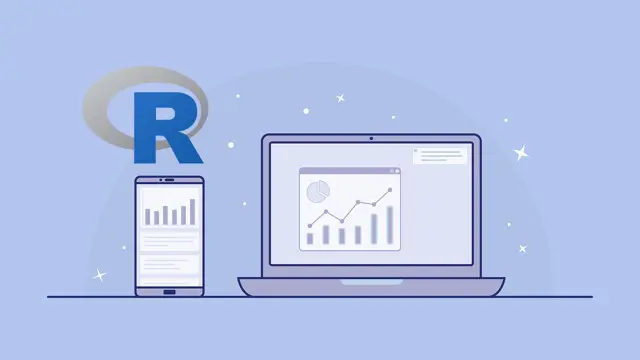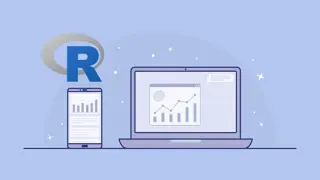
Bundle Multi (2-in-1) - R Programming
Self-paced videos, Lifetime access, Study material, Certification prep, Technical support, Course Completion Certificate
Uplatz
Summary
- Reed Courses Certificate of Completion - Free
- Uplatz Certificate of Completion - Free
Add to basket or enquire
Overview
Uplatz offers this comprehensive 2-in-1 multi bundle course on R Programming. It is a self-paced course with video lectures. You will be awarded Course Completion Certificate at the end of the course.
R is a programming language for statistical computing and graphics supported by the R Core Team and the R Foundation for Statistical Computing. Created by statisticians Ross Ihaka and Robert Gentleman, R is used among data miners, bioinformaticians and statisticians for data analysis and developing statistical software. Users have created packages to augment the functions of the R language. R is a language and environment for statistical computing and graphics.
R provides a wide variety of statistical (linear and nonlinear modelling, classical statistical tests, time-series analysis, classification, clustering, …) and graphical techniques, and is highly extensible. The S language is often the vehicle of choice for research in statistical methodology, and R provides an Open Source route to participation in that activity.
One of R’s strengths is the ease with which well-designed publication-quality plots can be produced, including mathematical symbols and formulae where needed. Great care has been taken over the defaults for the minor design choices in graphics, but the user retains full control.
R is an integrated suite of software facilities for data manipulation, calculation and graphical display. It includes
an effective data handling and storage facility,
a suite of operators for calculations on arrays, in particular matrices,
a large, coherent, integrated collection of intermediate tools for data analysis,
graphical facilities for data analysis and display either on-screen or on hardcopy, and
a well-developed, simple and effective programming language which includes conditionals, loops, user-defined recursive functions and input and output facilities.
In this R Programming course by Uplatz you will learn how to program in R and how to use R for effective data analysis. You will learn how to install and configure software necessary for a statistical programming environment and describe generic programming language concepts as they are implemented in a high-level statistical language. The course covers practical issues in statistical computing which includes programming in R, reading data into R, accessing R packages, writing R functions, debugging, profiling R code, and organizing and commenting R code. Topics in statistical data analysis will provide working examples.
Curriculum
Course media
Description
R programming is a language and environment for statistical computing and graphics. It was developed by Ross Ihaka and Robert Gentleman at the University of Auckland, New Zealand, and was first released in 1995. R provides a wide variety of statistical and graphical techniques, and it is widely used by statisticians, data scientists, and researchers for data analysis, visualization, and modeling.
Here are some key features of R programming:
Data Manipulation: R provides extensive tools for data manipulation, including functions for filtering, sorting, aggregating, merging, and reshaping data.
Statistical Analysis: R offers a rich set of statistical functions and packages for performing various statistical analyses, such as hypothesis testing, regression analysis, time series analysis, and clustering.
Data Visualization: R has powerful graphical capabilities, allowing users to create a wide range of high-quality data visualizations, including scatter plots, bar plots, histograms, line plots, and more. The "ggplot2" package is particularly popular for creating sophisticated and customizable plots.
Extensibility: R is highly extensible, allowing users to create their own functions and packages to extend its capabilities. There is a vast collection of packages available on the Comprehensive R Archive Network (CRAN) and other repositories, covering diverse domains and analysis techniques.
Reproducible Research: R facilitates reproducible research by providing tools for documenting code, generating reports, and creating interactive documents. Packages like R Markdown and knitr enable the integration of code, analysis, and results in a single document.
Integration: R can be easily integrated with other programming languages like Python, Java, and C++, allowing users to leverage existing libraries and tools for specific tasks. Additionally, R has connectors to various databases, making it convenient for data extraction and manipulation.
Who is this course for?
Everyone
Requirements
Passion & determination to achieve big goals in life!
Career path
- Software Engineer
- R Programmer
- Data Scientist
- Data Analyst
- Machine Learning Engineer
- Data Consultant
- Software Developer
- Business Analyst
- Financial Analyst
Questions and answers
Currently there are no Q&As for this course. Be the first to ask a question.
Certificates
Reed Courses Certificate of Completion
Digital certificate - Included
Will be downloadable when all lectures have been completed.
Uplatz Certificate of Completion
Digital certificate - Included
Course Completion Certificate by Uplatz
Reviews
Currently there are no reviews for this course. Be the first to leave a review.
Legal information
This course is advertised on reed.co.uk by the Course Provider, whose terms and conditions apply. Purchases are made directly from the Course Provider, and as such, content and materials are supplied by the Course Provider directly. Reed is acting as agent and not reseller in relation to this course. Reed's only responsibility is to facilitate your payment for the course. It is your responsibility to review and agree to the Course Provider's terms and conditions and satisfy yourself as to the suitability of the course you intend to purchase. Reed will not have any responsibility for the content of the course and/or associated materials.


